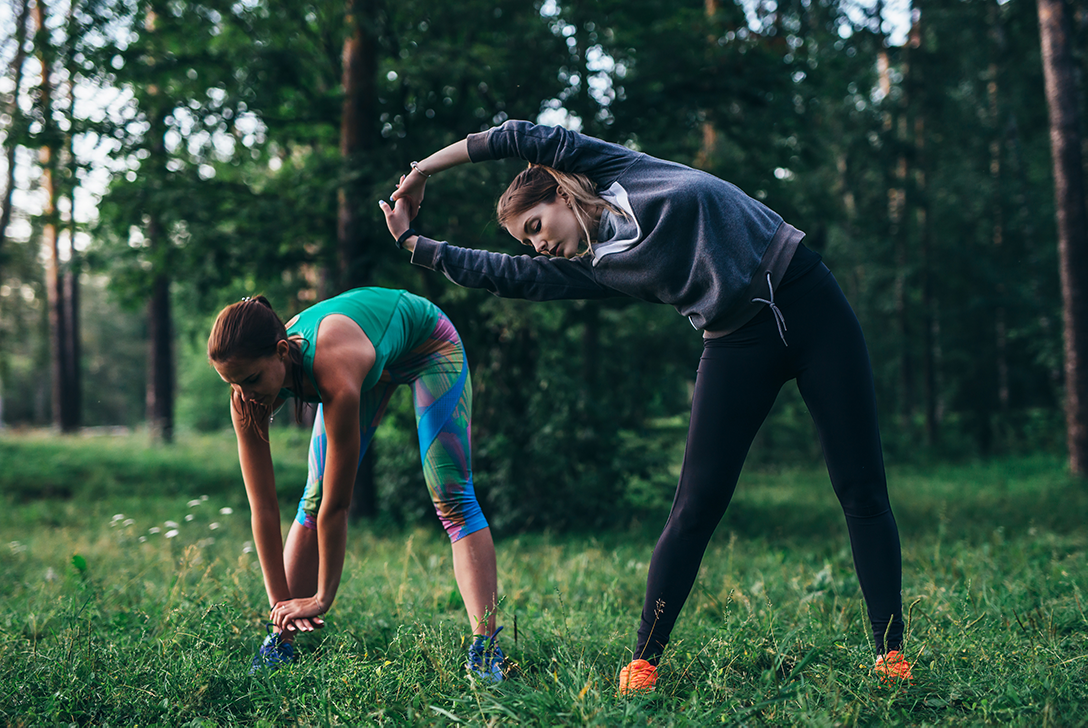If you stretch before you run to protect yourself from injury, you’re barking up the wrong tree. What stretches are really for and how to go about them.
Stretching prevents injuries.
False. For a long time, the motto before running was “stretch, stretch, stretch”. However, the fact that it prevents injuries has been disproved by many studies. Warming up, on the other hand, minimizes the risk of injury. It is enough to take things slowly – in the truest sense of the word – such as walking briskly before jogging. Regular strength training is also more effective in this respect, and this is one of the reasons why runners should not neglect it.
Stretching improves mobility.
True. How mobile a person is depends, among other things, on his or her age, gender, genes, training condition, pain tolerance, warm-up condition and outside temperature. With age, for example, the content of elastin in connective tissue decreases, which reduces mobility. Pain-induced relieving postures additionally reduce it. However, regular stretching is not only useful for older runners, but also for all those who spend many hours at an office desk. For long-term success, stretching exercises lasting about 30 seconds are needed three to five times a week.
Regular stretching lengthens the muscles.
True. In the long term, i.e. after a few months, stretching can make muscles longer. However, for this to happen, they need to be stretched regularly and intensively. Other effects of stretching – but usually only short-term – are probably that you get used to a higher muscle tension, develop an increased pain tolerance, perceive your body better or a combination of several such factors.
Stretching before exercising is a must.
False. It depends entirely on the activity. Stretching exercises are important to warm up before activities that involve large ranges of motion, such as gymnastics or ballet. Before jogging, on the other hand, they are not a must. Every runner is different, has different conditions and should therefore find out whether he or she needs stretches and what works best for him or her. There is no one exercise for everyone.
Before exercise, you should not stretch too much.
True. It is believed that long (more than 30 seconds), intense, static stretching exercises have a negative effect on the muscle’s force production and performance.
There are different types of stretches.
True. Static stretching involves pulling the muscle lengthwise and stretching it by holding it in that position for a few seconds to minutes. Dynamic stretching, on the other hand, is integrated into the movement, such as lunges. Rocking or springy movements and swings are variations of dynamic stretching. The third technique is called postisometric relaxation. Here, the muscle that is to be stretched is briefly tensed and then stretched. An exercise for the muscles of the front of the thigh, for example, goes like this: Grasp the lower end of the shin with one hand and bring the heel as far as possible to the buttocks. Then press the lower leg against the hand for a few seconds (the hand gives resistance), relax again and stretch for a few seconds.
After hard training, strenuous stretching exercises are counterproductive.
True. The muscle is stressed by the very high intensity training, and the micro muscle tears caused by this can be exacerbated by stretching. Therefore, do stretching exercises gently only after light training sessions or do them on another day!
Stretches prevent muscle soreness.
False. Stretching performed before and/or after exercise have no proven positive effect on muscle soreness.
Stretches also have an impact on the fasciae.
True. Fascia surrounds the muscles like a sheath. If the muscles are stretched, the fasciae are automatically stretched as well.
After an injury, you have to stretch.
False. In the early stages of an injury, intense stretching can actually be harmful, and should therefore be done gently at most, or not at all. Later, stretching can be helpful, depending on the injury. If a joint has limited motion after an injury, stretching can help restore mobility. Rather than stretching, the focus after an injury is on increasing the resilience of the injured structure through exercise. Incidentally, utilizing the full range of motion during exercises can also promote mobility at the same time.
Tips
- To achieve a lasting change in flexibility you should stretch regularly at least three times a week.
- Stretching should put the body in an uncomfortable position, but not be too painful.
- The most important joint for runners is the ankle. To make it more mobile, it is important to stretch the calf muscles, for example by lowering the heel on a step.
- Dynamic stretching exercises such as lunges, standing balances or hip circles can easily be incorporated into the warm-up program and prepare joints and muscles for the stress ahead.
- Stretching can also be combined with preliminary self-massage with the hands, a fascia roller, or a massage ball on the same muscle.
- Yoga can also be beneficial because it involves comprehensive movements that are not common in everyday life. Yoga is a gentle flexibility training, where you get into uncomfortable positions, but they should not hurt. It takes months for the body to get used to it, and you should give it that time.
- Find what works for you! Everyone has to find out for themselves in what form and whether stretching is at all something for them.
This might also interest you:
No matter what level of athleticism and no matter how much time you have, a targeted training helps you to get the most out of your prerequisites and guarantees a long-term increase in performance. The right dosage of load and rest protects you from overload and also maintains your performance in everyday life. The content of the training and the scope of our advice is individually tailored to your needs. You can find more information here.



